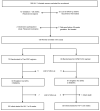Compliance with antiretroviral regimens to prevent perinatal HIV-1 transmission in Kenya
- PMID: 12478070
- PMCID: PMC3387271
- DOI: 10.1097/00002030-200301030-00009
Compliance with antiretroviral regimens to prevent perinatal HIV-1 transmission in Kenya
Abstract
Objective: To compare compliance and infant HIV-1 infection risk at 6 weeks with the Thai-CDC and HIVNET-012 antiretroviral regimens in a field setting.
Design: Randomized clinical trial.
Setting: Tertiary hospital antenatal clinic in Nairobi, Kenya.
Participants: HIV-1 infected women referred from primary care clinics.
Interventions: Thai-CDC zidovudine regimen or HIVNET-012 nevirapine regimen.
Main outcome measures: Women were considered compliant if they used >or= 80% of the doses. Infants were tested for HIV-1 at 6 weeks. RESULTS Seventy women were randomized to Thai-CDC and 69 to HIVNET-012 regimens. More women were compliant with the antenatal (86%) than the intrapartum (44%) Thai-CDC regimen doses ( P= 0.001). Ninety-seven per cent took the maternal and 91% gave the infant dose of the HIVNET-012 regimen (P = 0.2). Overall, 41% were compliant with the Thai-CDC regimen and 87% with the HIVNET-012 regimen ( P< 0.001). Compliance with the Thai-CDC regimen was associated with partner support of antiretroviral use [odds ratio (OR), 3.0;, 95% confidence interval (CI), 1.0-9.1] and knowledge at recruitment that antiretroviral drugs could prevent infant HIV-1 (OR, 2.9; 95% CI, 1.0-8.1). Compliance with the HIVNET-012 regimen was associated with partner notification (OR, 8.0; 95% CI, 1.5-50) and partner willingness to have HIV-1 testing (OR, 7.5; 95% CI, 1.4-40). There was a trend for a higher risk of transmission with the HIVNET-012 regimen than with the Thai-CDC regimen (22% versus 9%; P= 0.07).
Conclusion: Compliance with the Thai-CDC and HIVNET-012 regimens was comparable to that in efficacy trials. Partner involvement, support and education on perinatal HIV-1 prevention may improve compliance and increase the number of infants protected from HIV-1 infection.
Figures
References
-
- Guay LA, Musoke P, Fleming T, Bagenda D, Allen M, Nakabiito C, et al. Intrapartum and neonatal single-dose nevirapine compared with zidovudine for prevention of mother-to-child transmission of HIV-1 in Kampala Uganda: HIVNET 012 randomised trial. Lancet. 1999;354:795–802. - PubMed
-
- Shaffer N, Chuachoowong R, Mock PA, Bhadrakom C, Siriwasin W, Young NL, et al. on behalf of the Bangkok Collaborative Perinatal HIV Transmission Study Group Short-course zidovudine for perinatal HIV-1 transmission in Bangok, Thailand: a randomized controlled trial. Lancet. 1999;353:773–780. - PubMed
-
- UNAIDS. WHO Report on the global HIV/AIDS epidemic: Global HIV/AIDS and STD Surveillance. 2000 http://www.unaids.org/epidemic_update/report/index.html.
-
- Wiktor SZ, Ekpini E, Karon JM, Nkengasong J, Maurice C, Severin ST, et al. Short course oral zidovudine for prevention of mother-to-child transmission of HIV-1 in Abidjan, Cote d’Ivoire: a randomized trial. Lancet. 1999;353:781–785. - PubMed
-
- Statistics Division of the United Nations Secretariat and International Labour Office Indicators of income and economic activity. 1999 http://www.un.org/depts/unstd/social/inc-eco.htm.
Publication types
MeSH terms
Substances
Grants and funding
LinkOut - more resources
Full Text Sources
Medical


